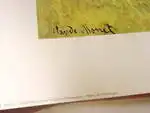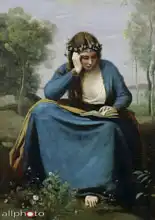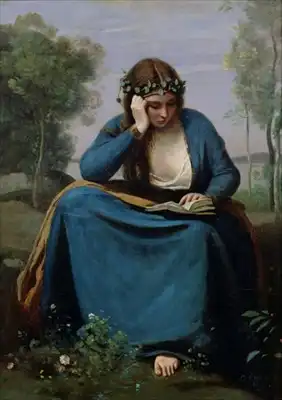About this finishing
Print. The image is printed on the top quality 10-ink HP Z9PS printer on HP matte 270 g / m2 paper. You can choose any size to an accuracy of 1 cm. A margin of 5 cm around the image is added to the size of the motif.


You can find a detailed description about our finishings
here.
Reader with flowers
Date:
1845Medium:
oil on canvasLocation:
Louvre, Paris, FranceDimensions:
47 x 34The picture shows a woman sitting on a meadow with her legs folded. She is wearing a blue garment with a white background and a wreath of leaves on her head. She is intensely enjoying reading a book which she is holding in her right hand. He looks thoughtful and concentrated. Her bare feet are visible from under the blue bedspread. The surroundings are an idyllic landscape with a few trees and a blue sky.
This description was created by artificial intelligence, please be indulgent.
Corot painted picture Reader with flowers in 1845. Prevailing color of this fine art print is blue and its shape is portrait. Original size is 47 x 34. This art piece is located in Louvre, Paris, France. This image is printed on demand - you can choose material, size and finishing.
Jean-Baptiste Camille Corot (1796-1875). French landscape painter. Corot was the leading artistic figure of the Barbizon school of painting in France in the mid-19th century. He was a central figure in landscape painting. His work is characterized by a simultaneous connection of neoclassicism and the beginning of open-air
impressionism. It was in reference to him that
Claude Monet exclaimed: There is only one artist - Corot. We are nothing compared to him, nothing. Equally important is Corot’s contribution to figural painting -
Degas even preferred Corot’s figures to his landscapes. The figural motifs painted by Picasso in the classic style are considered
Picasso’s homage to Corot’s style. Historians loosely divide his work into different periods, but the boundaries are not specified, which was also contributed to by Corot’s custom of finishing paintings sometimes even years after beginning them.
Corot’s approach to landscape is far more traditional than it would seem. When comparing his later paintings of trees with some compositions of
Claude Lorrain, such as those exhibited in the Bridgewater gallery, the similarity in technique is striking. In addition to landscapes, of which Corot painted several hundred (the most popular were those painted at a later date), Corot created a number of highly acclaimed figurative paintings. Mostly curtly cartoons, these are paintings created in the studio with the intention of keeping them as private property rather than selling them. Yet many of them have a great composition, and the colours are in any case remarkable for their strength and purity.

